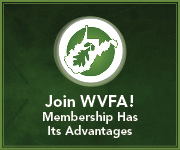Industry News
|
Taken from information provided WVFA by Kathy Becket, Steptoe & Johnson PLLC.
It is possible that the northern long-eared bat (NLEB) will be listed as endangered, under the Endangered Species Act, in 39 States; including West Virginia. Since the October 2, the proposed listing of the NLEB as endangered or threatened has generated over 37,000 comments, letters of concern and support filed with the U.S. Fish & Wildlife Service (78 Fed. Reg. 61046). The U.S. Fish & Wildlife Service (USFWS) has determined that the NLEB is in danger of extinction, predominantly due to the threat of white-nose syndrome. Visit https://www.naylornetwork.com/wvf-nwl/articles/?aid=268058&issueID=40907 to view the full article online. |
Education Opportunities
|
The way America's youth learn about the environment will largely determine the future quality of life for generations to come. Environmental education is necessary to help students understand the environmental challenges of not just today, but also of tomorrow. Quality environmental education teaches students the skills they need to be informed decision makers, and provides critical tools for a 21st century workforce faced with devising solutions to increasingly complex environmental issues, like climate change and energy.
Project Learning Tree® (PLT) is a program of the American Forest Foundation that uses the forest as a window on the world, engaging the next generation of America's thought-leaders and decision makers. We provide educators with peer-reviewed, award-winning environmental education curriculum resources that can be integrated into lesson plans for all grades and subject areas. Developed in 1976, our 50-state network includes more than 500,000 trained educators and materials that cover the total environment. PLT in the classrooms helps educators teach tomorrow’s decision-makers how to think, not what to think, about complex environmental issues. Visit https://www.naylornetwork.com/wvf-nwl/articles/?aid=271522&issueID=40907 to view the full article online. |
Forestry Facts
|
The decision to initiate a timber harvest can often be bewildering and even frightening. As a forest landowner, you are responsible for the activities that take place on your property. However, there are educational and technical programs available to assist you in the selling of your forest products by calling the phone numbers of the organizations listed in this brochure. A nine-part educational video series is available at West Virginia public libraries or through these various organizations.
Visit https://www.naylornetwork.com/wvf-nwl/articles/?aid=268061&issueID=40907 to view the full article online. |
Other
|
National trends show that wildfire risk and the size of many wildfires are growing. The West Virginia Division of Forestry (DOF) continues to educate residents and communities about what they can do to prepare before a wildfire strikes their area. Wildfires DO NOT have to burn everything in their paths.
In simple terms, West Virginia burning law is: Fire season is March 1- May 31 AND October 1-December 31. Burning is allowed during these months between 5:00 p.m. and 7:00 a.m. Burning is allowed at any time during the other months of the year. NOTE: Also, if you are within city limits, be sure to check on city ordinances that may apply. Visit https://www.naylornetwork.com/wvf-nwl/articles/?aid=270460&issueID=40907 to view the full article online. |


